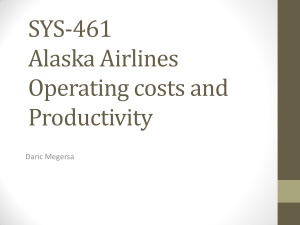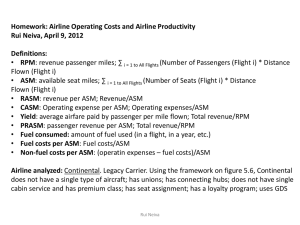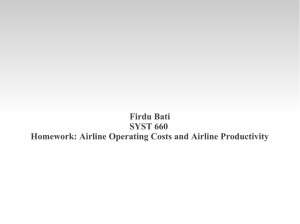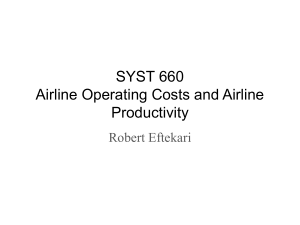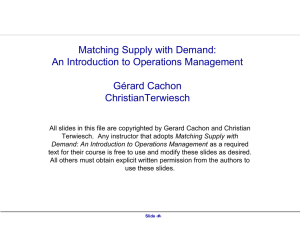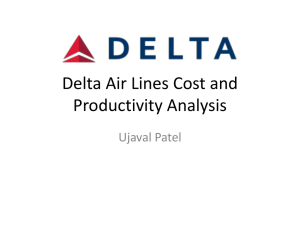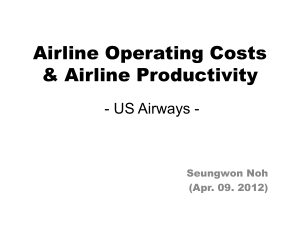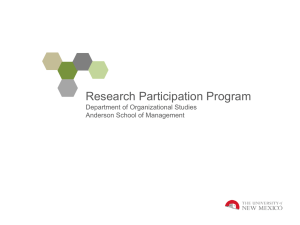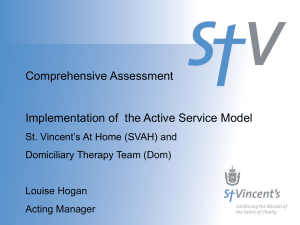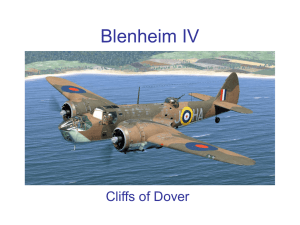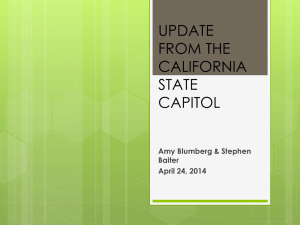Homework 4 (Airline Cost Analysis
advertisement
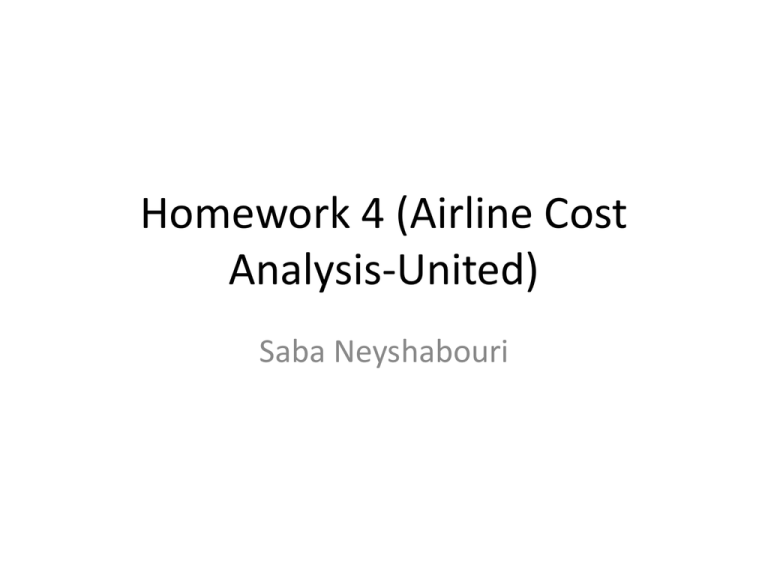
Homework 4 (Airline Cost Analysis-United) Saba Neyshabouri Airline of Study • United Airlines – United Airline is listed as a Legacy carrier – Typical characteristics of legacy carriers are that they provide a higher level of services than a low-cost carrier; for example, a legacy carrier typically offers first class and/or business class, a frequent-flyer program, airport lounges, and is a member of an airline alliance through which it has partners that agree to provide these services to its passengers as well. Also, there is a higher level of services in the cabin, such as meal service and in-flight entertainment. United (NLC) • Operating major hubs – – – – – – – – – – – O'Hare International Airport, Chicago, Illinois George Bush Intercontinental Airport, Houston, Texas Denver International Airport, Denver, Colorado Washington Dulles International Airport, Washington, DC San Francisco International Airport, San Francisco, California Maintenance hub (MRO) San Francisco International Airport, San Francisco Los Angeles International Airport, Los Angeles, California Narita International Airport, Tokyo, Japan Newark Liberty International Airport, Newark, New Jersey Cleveland Hopkins International Airport, Cleveland, Ohio Antonio B. Won Pat International Airport, Guam United (NLC) • Serving domestic markets as well as international – Transcontinental – Transatlantic – Transpacific Definitions • RPMs : – Revenue Passenger Miles= sum of all the paying passengers multiplied by the distance travelled. • ASMs : – Available Seat Miles= sum of all the seat flown (available) multiplied by the distance travelled. • RASM : – Revenue per Available Seat Miles=It is obtained by dividing operating income by available seat miles (ASM). Definitions • CASM : – Cost per Available Seat Miles: It is obtained by dividing the operating costs of an airline by available seat miles (ASM) • Yield : – Average fare paid by passengers, per mile flown : Revenue per RPM • PRASM : – Passenger Revenue per Available Seat Miles: It is calculated by dividing passenger revenue by available seat miles. Typically the measure is presented in terms of cents per mile. This measure is equivalent to the product of load factor and yield. Definitions • Fuel Consumed : – Sum of all the fuel expenses for all the flights operated. • Fuel Cost per ASM : – Fuel consumed divided by Available Seat Miles (ASM) • Non Fuel Cost per ASM : – Total non fuel costs divided by Available Seat Miles (ASM) Chart 1 (RPM-ASM-LF) 50000 100.00% 45000 90.00% 40000 80.00% 35000 70.00% 30000 60.00% 25000 50.00% 20000 40.00% 15000 30.00% 10000 20.00% 5000 10.00% RPM 0 0.00% 0 5 10 15 20 25 30 35 40 ASM LF Chart 1 • In 2002 there has been a drop in ASM and RPM and load factors. • The seasonal behavior of ASM, RPM and subsequently load factor can be seen through the wave motions. • Load factor has been increased while RPM has been approximately held constant after 2004 but ASM has been reduced. Chart 2(Income-Expense-Revenue) 10000 8000 6000 4000 Income(loss) before tax Total Operating Expense 2000 Total Operating Revenue 0 0 -2000 -4000 5 10 15 20 25 30 35 40 Chart 2 • Operating revenue is following costs closely, however it is standing below the cost line for most of the time. • Total operating expenses shows small seasonal changes and has been growing from 2003 to 2008. • Income before taxation is mostly negative and varying small showing some seasonal changes . Chart 3(RASM-CASM-Yield per RPM- PRASM) 25.00 20.00 15.00 RASM CASM Yeild per RPM PRASM 10.00 5.00 0.00 0 5 10 15 20 25 30 35 40 Chart 3 • RASM shows some growth after some variations in 2001-2003 with small seasonal changes. • CASM also shows the behavior close to RASM. • PRASM is having the same behavior while being smaller than RASM and CASM showing that Passengers are not the only source of revenue and can not cover the costs alone. • Yield per RPM shows some variations in years, but it has generally increased: – y = 0.0492x + 12.282 – R² = 0.0656 Chart 4 (Fuel vs. Non fuel) 7000 3000 6000 2500 5000 2000 4000 1500 Non-Fuel Cost Aircraft Fuel 3000 1000 2000 500 1000 0 0 0 5 10 15 20 25 30 35 40 Chart 4 • In United, big chunk of costs are non-fuel operational expenses. • Non-fuel expenses has been some what steady with some peaks. • Fuel costs has been steadily growing until a drop happened at the end of 2008. • In United non-fuel costs are major operating costs and they out weigh fuel costs. Chart 5 (Costs per ASM and Fuel Price) 0.2 4 0.18 3.5 0.16 3 0.14 2.5 0.12 NonFuel/ASM 0.1 2 Fuel/ASM Fuel Price 0.08 1.5 0.06 1 0.04 0.5 0.02 0 0 0 5 10 15 20 25 30 35 40 Chart 5 • As non-fuel cost has been some what steady, non-fuel costs per ASM has also been steady with some few peaks and small variations representing the seasonality. – y = -6E-05x + 0.1071 – R² = 0.001 • Fuel costs per ASM has growth steady with a drop at the end of 2008 which follows the fuel price behavior closely – y = 0.001x + 0.0099 – R² = 0.544 • Fuel Price has shown an overall increase during these time, however the decrease started at the end of 2008 – y = 0.0581x + 0.4556 – R² = 0.6078 Effect of Fuel Price on Expenses • What can be seen from these charts is that fuel price increase has effectively changed the fuel costs. • While RPM has not changed, RASM has increased with slow rate. • Decreasing ASM has helped to keep the costs from growing • Increasing load factors has improved efficiency and keep the costs from growing. • Non-fuel costs are still the major cost for United Airline Finance • It can be seen that United has not done very good in terms of business while the most of the time, they have had loss. • Trend shows they have reduced the loss over time but in 2008 they have had major loss (recession) 10000 8000 Income(l oss) before tax 6000 4000 Total Operatin g Expense 2000 0 0 -2000 -4000 10 20 30 40 Total Operatin g Revenue Airline Network Structure 50000 100.00% 45000 90.00% 40000 80.00% 35000 70.00% 30000 60.00% 25000 50.00% 20000 40.00% 15000 30.00% 10000 20.00% 5000 10.00% • Network Load Factor (LF) has been steadily improved with small variations in seasons – y = 0.0037x + 0.7162 – R² = 0.4694 RPM 0 0.00% 0 10 20 30 40 ASM LF • Increased fuel costs will push the airline to operate with more efficiency and take advantage of their seat inventory. • Increased fuel costs has pushed the airline to reduce ASM (operating AC) to mitigate the costs.
